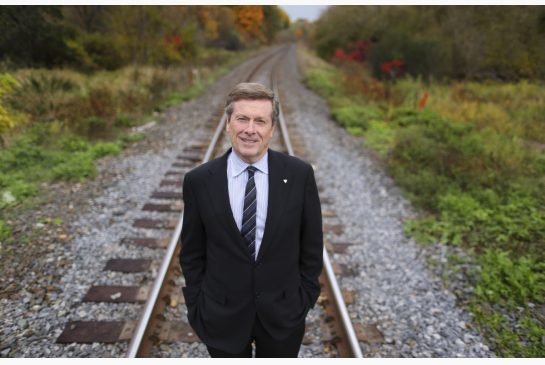We need to ask tough questions about SmartTrack: Editorial
Toronto Mayor John Tory’s SmartTrack transit plan deserves a thorough airing including all its uncertainties. If that means being a ‘Debbie Downer,’ so be it.
A
A
| Comments | ? |
| Report an Error |
Share via Email

Richard Lautens / Toronto Star Order this photo
Toronto Mayor John Tory campaigned on a promise to bring in his SmartTrack transit plan.


Sorry to be what you call a Douglas or Debbie Downer, Mr. Mayor. But grave questions muddle the future of your much-vaunted SmartTrack transit plan. And it’s important to face them head-on rather than taking refuge in feel-good bromides.
Commuters, and Torontonians at large, deserve to get all available information on the status of this $8-billion project — including frank discussion of the hurdles that remain to be overcome.
On the bright side, one major obstacle has already been surmounted with federal leaders, including prime minister-designate Justin Trudeau, pledging to pay Ottawa’s $2.6-billion share of the bill. Mayor John Tory has good reason to celebrate this win.
But his election promise to deliver a 53-kilometre, 22-station “surface subway” line in just seven years, and at no cost to Toronto’s property tax payers, remains far from safe arrival. Indeed, given that one year has already gone, it’s a near certainty that SmartTrack won’t be completed on schedule — if it’s built at all.
A report to the city’s executive committee this week highlighted some of the troubling doubts that cloud the project. A key selling point on the mayoral election trail last year was that SmartTrack service would run mainly on existing rails used by GO Transit trains. Relatively little new track would have to be installed.
But GO has plans of its own, including a dramatic expansion of regional express rail service, and that isn’t necessarily compatible with Tory’s transit vision. Metrolinx, the agency in charge of co-ordinating transit across the Greater Toronto Area, sees SmartTrack as merely “an incremental increase” in GO Transit service instead of an independent and parallel operation. That’s not what Tory promised.
According to the report from city staff, SmartTrack would provide something different from GO’s regional express routes, offering more frequent service and additional stations. For now, the degree to which these lines could be integrated remains “subject to future discussion.”
One way SmartTrack takes a different direction from GO involves the proposed construction of a rail link to Mississauga’s job-rich airport corporate centre. But the staff report found this would require expensive and complicated tunnels and elevated sections, and would have “significant impacts” on the surrounding community. That’s likely to be opposed.
Other uncertainties include a lack of reliable ridership estimates, questions about whether Union Station could handle a flood of new SmartTrack commuters, and doubt about the practicality of paying the city’s costs by borrowing against future development.
It all adds up to a transit option that’s well worth exploring, but which warrants clear-eyed discussion of the potential complications and very real risks — however much of a “downer” that may be.
Top News
- NEW Ontario gave school boards $4.6M to help cover bargaining costs
- Cancer risk from processed meat ranks with smoking, says WHO
- Women’s College researcher 'manipulated' study results
- NEW Canada Post placing community mailboxes despite Liberal pledge
- Ex-MP wants ‘new’ dropped from NDP name
- John Baird addresses Tory leadership rumours
- All five dead in B.C. whale-watching boat capsize are Britons
- The Animal Scam: Star Touch exclusive


We value respectful and thoughtful discussion. Readers are encouraged to flag comments that fail to meet the standards outlined in our Community Code of Conduct. For further information, including our legal guidelines, please see our full website Terms and Conditions.
Commenting is now closed.
There are -- comments. Show comments.